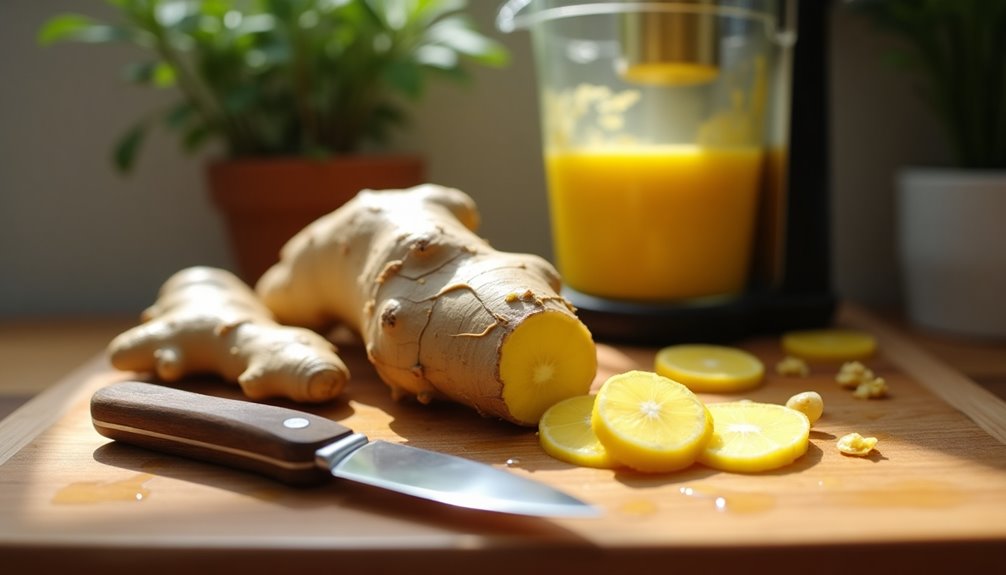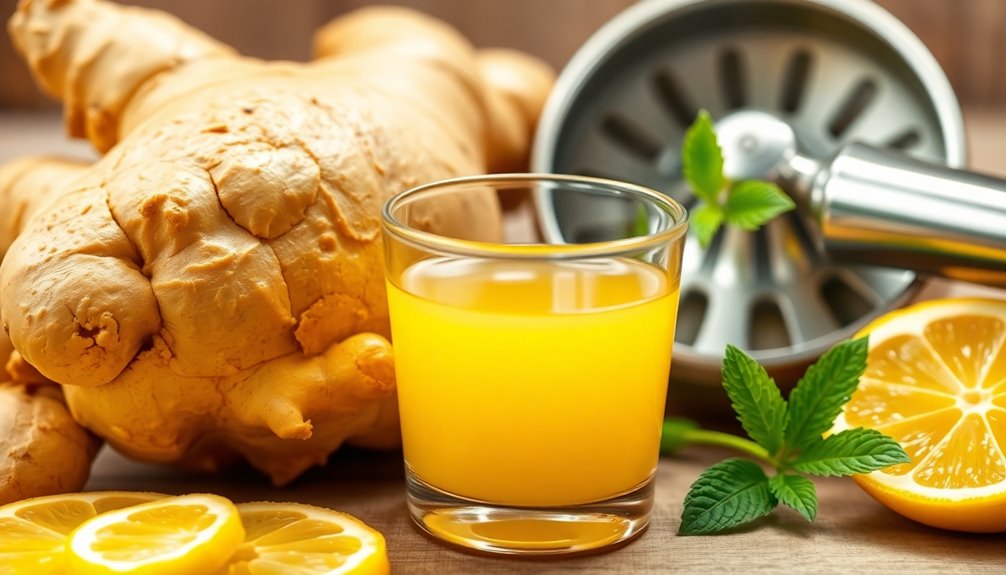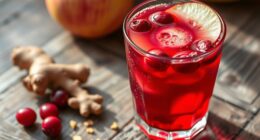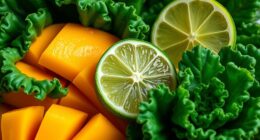Juicing a ginger root is easy! First, clean the ginger with a kitchen brush and rinse it. Chop the ginger into small pieces. If you're using a juicer, just feed the pieces in. For a blender, blend the chopped ginger with water (1 lb ginger to 3 cups water) until smooth, then strain it. Store your fresh juice in an airtight container in the fridge for a few days. Want to discover more ways to use that ginger juice?
Key Takeaways
- Clean fresh ginger root thoroughly using a kitchen brush and rinse under water to remove any dirt.
- Chop ginger into 2-inch pieces if using a juicer; peel if using a blender for a smoother texture.
- For juicing, feed chopped ginger into a juicer or blend with water (1 lb ginger to 3 cups water) for the blender method.
- Strain the blended mixture using a fine mesh strainer or nut milk bag to extract maximum liquid from the ginger pulp.
- Store the strained ginger juice in an airtight glass container in the refrigerator for 2-3 days, or freeze in ice cube trays for longer preservation.

Juicing a ginger root is a simple way to unlock its vibrant flavor and health benefits. Whether you're looking to add a zing to your recipes or harness the natural properties of ginger for wellness, you'll find that making homemade ginger juice is both easy and rewarding. To get started, you'll need to gather a few essential items: fresh ginger root, a juicer or a blender, and some water.
First, you'll want to clean the ginger thoroughly. Use a kitchen brush and rinse it under water, ensuring no dirt remains on the surface. This step is crucial, especially if you're using organic ginger, which doesn't require peeling.
Once the ginger is clean, you can choose your method for juicing. If you're using a juicer, chop the ginger into smaller pieces, about 2-inch sections, and feed them directly into the juicer. The juicer will efficiently extract the juice, leaving you with a concentrated and flavorful liquid.
Alternatively, if you're opting for the blender method, start by peeling the ginger if you prefer. While it's not necessary, some people enjoy a smoother texture without the skin. Chop the ginger into 1-inch pieces and blend it with water at a ratio of 1 pound of ginger to 3 cups of water. Blend until smooth, as this will help to extract the juice more effectively.
After blending, it's time to strain the juice. Use a fine mesh strainer or a nut milk bag to separate the liquid from the pulp. Pour the blended mixture into the strainer, then press down firmly to extract as much liquid as possible. This step is vital for getting the most juice out of your fresh ginger root.
Once you've strained the juice, you'll have a vibrant, spicy liquid that's ready for use.
Now, you'll want to store your homemade ginger juice properly. Pour the freshly extracted ginger juice into an airtight glass container and store it in the refrigerator. It'll stay fresh for up to 2-3 days, allowing you to enjoy it in various ways, from adding it to smoothies to using it in salad dressings.
If you want to preserve it for longer, consider freezing the juice in ice cube trays. This way, you can easily pop out a cube whenever you need a quick burst of flavor or health benefits.
Frequently Asked Questions
How to Get Juice From a Ginger Root?
To get juice from a ginger root, start by washing it thoroughly.
If it's organic, you can skip peeling. Cut the ginger into smaller pieces for easier juicing.
If you're using a juicer, just feed those pieces in. For a blender, blend the chopped ginger with a cup of water and strain the mix.
Aim for about 30ml daily to enjoy its health benefits.
Store any leftover juice properly to keep it fresh!
Do You Need to Peel Ginger Before Juicing?
Did you know that ginger contains over 400 different compounds, many of which are beneficial to your health?
When it comes to peeling ginger before juicing, it depends on whether it's organic or not. If it's organic, you can skip peeling since the skin's edible.
For non-organic ginger, it's best to peel to avoid pesticides.
If you're using a juicer, you can also juice it without peeling, as it handles the skin and pulp.
Is It Better to Boil or Juice Ginger?
When deciding whether to boil or juice ginger, juicing's your best bet for health benefits.
Juicing preserves the raw nutrients and active compounds, like gingerol, that boiling can diminish. You'll get higher levels of antioxidants from fresh ginger juice, which supports digestion and reduces inflammation more effectively.
While boiling might enhance flavor, it takes longer and alters nutritional value. For maximum potency, stick with juicing ginger to enjoy its full health benefits.
What Happens if I Drink Ginger Water Every Day?
If you drink ginger water every day, you'll likely notice several health benefits.
It can aid digestion, reduce bloating, and even help with nausea. You might find it supports your immune system and keeps you feeling energized by regulating blood sugar levels.
Plus, its anti-inflammatory properties could assist with weight loss by revving up your metabolism.
Conclusion
Juicing ginger root is a simple process that can spice up your drinks and boost your health. Just remember, when you're grating or blending, you're channeling the same energy as a medieval alchemist crafting potions. So, whether you're adding it to smoothies or teas, you'll unlock a world of flavor and benefits. Don't hesitate to experiment and find what works best for you. Your taste buds (and your body) will thank you for it!
Cindy thoroughly researches juicing trends, techniques, and recipes to provide readers with practical advice and inspiration. Her writing style is accessible, engaging, and designed to make complex concepts easy to understand. Cindy’s dedication to promoting the advantages of juicing shines through her work, empowering readers to make positive changes in their lives through the simple act of juicing.











